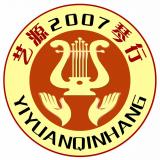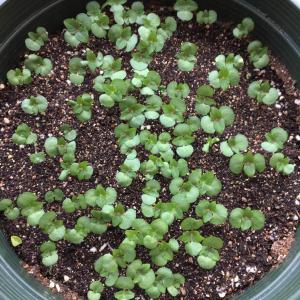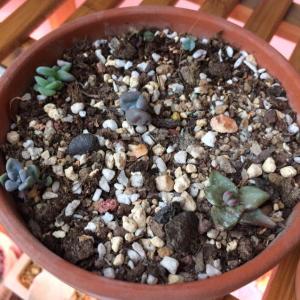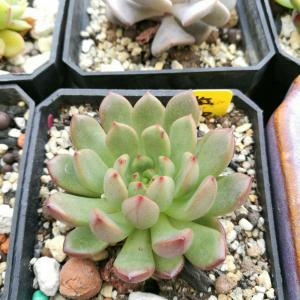文章
Dummer. ゛☀
2017年07月30日

Family - Fabaceae
Stems - From a taproot, widely branching above the base, herbaceous but stout at the base, erect to ascending, to +/-50cm tall, antrorse pubescent.

Leaves - Alternate, stipulate, even-pinnate, with +/-11 pairs of leaflets. Stipules erect, appressed, lanceolate, striate-nerved, to 6mm long, green but often with a reddish apex, antrorse strigose (at least on the margins). Gland of the petiole stalkless, to about .6mm in diameter, purplish. Petiole and rachis antrorse pubescent. Leaflets sessile, opposite, entire, to 1.4cm long, 4mm broad, linear-oblong, oblique at the base, rounded and mucronate at the apex, with antrorse strigose margins, glabrous and deep green adaxially, light green and glabrous abaxially, lateral veins evident abaxially.

Inflorescence - Fascicles of 4-5 flowers from the side of the stem (within the internode). Each flower subtended by a linear-lanceolate bract. Bracts exceeding the pedicel. Pedicels short, to 1.2mm long.
Flowers - Petals 5, yellow, unequal, glabrous, distinct. Lowest petal enlarged, to -9mm long, 7-8mm broad, rotund. Upper petals smaller than the lowest, cupped around the other floral organs, at least one of the lateral petals with erose margins. Stamens 5, distinct, glabrous. Filaments whitish, short (to 1.2mm long). Anthers purplish to reddish, apically dehiscent, 2.5mm long. Ovary green, superior, 3mm long, densely appressed pubescent. Style up-curved, -2mm long, greenish, glabrous. Calyx deeply 5-lobed, the tube sparse pubescent, green, -1mm long. Lobes spreading, yellowish, linear-lanceolate, entire, sparse antrorse pubescent externally, glabrous internally, +/-5mm long, 1.2mm broad, often folded slightly.

Flowering - July - September.
Habitat - Slopes, ridges, open woods, prairies, thickets, roadsides, railroads. Usually on acid soils.
Origin - Native to U.S.
Other info. - This little species can be found mainly in the southern 1/2 of Missouri. The plant is easy to ID in the field because of its small yellow flowers and finely pinnate leaves. The leaves are sensitive to the touch and will close when touched or when hit by strong sunlight. This action, however, is not nearly as quick or dramatic as it is in other species from the family.
Traditionally the roots of this species were used to make a tea that was believed to relieve fatigue. The fruits of C. nictitans can be glabrous or spreading hairy and are eaten by wildlife.
Stems - From a taproot, widely branching above the base, herbaceous but stout at the base, erect to ascending, to +/-50cm tall, antrorse pubescent.

Leaves - Alternate, stipulate, even-pinnate, with +/-11 pairs of leaflets. Stipules erect, appressed, lanceolate, striate-nerved, to 6mm long, green but often with a reddish apex, antrorse strigose (at least on the margins). Gland of the petiole stalkless, to about .6mm in diameter, purplish. Petiole and rachis antrorse pubescent. Leaflets sessile, opposite, entire, to 1.4cm long, 4mm broad, linear-oblong, oblique at the base, rounded and mucronate at the apex, with antrorse strigose margins, glabrous and deep green adaxially, light green and glabrous abaxially, lateral veins evident abaxially.

Inflorescence - Fascicles of 4-5 flowers from the side of the stem (within the internode). Each flower subtended by a linear-lanceolate bract. Bracts exceeding the pedicel. Pedicels short, to 1.2mm long.
Flowers - Petals 5, yellow, unequal, glabrous, distinct. Lowest petal enlarged, to -9mm long, 7-8mm broad, rotund. Upper petals smaller than the lowest, cupped around the other floral organs, at least one of the lateral petals with erose margins. Stamens 5, distinct, glabrous. Filaments whitish, short (to 1.2mm long). Anthers purplish to reddish, apically dehiscent, 2.5mm long. Ovary green, superior, 3mm long, densely appressed pubescent. Style up-curved, -2mm long, greenish, glabrous. Calyx deeply 5-lobed, the tube sparse pubescent, green, -1mm long. Lobes spreading, yellowish, linear-lanceolate, entire, sparse antrorse pubescent externally, glabrous internally, +/-5mm long, 1.2mm broad, often folded slightly.

Flowering - July - September.
Habitat - Slopes, ridges, open woods, prairies, thickets, roadsides, railroads. Usually on acid soils.
Origin - Native to U.S.
Other info. - This little species can be found mainly in the southern 1/2 of Missouri. The plant is easy to ID in the field because of its small yellow flowers and finely pinnate leaves. The leaves are sensitive to the touch and will close when touched or when hit by strong sunlight. This action, however, is not nearly as quick or dramatic as it is in other species from the family.
Traditionally the roots of this species were used to make a tea that was believed to relieve fatigue. The fruits of C. nictitans can be glabrous or spreading hairy and are eaten by wildlife.
0
0
文章
Dummer. ゛☀
2017年07月25日

Family - Bignoniaceae
Stems - Woody, climbing or clambering, multiple from base, forming aerial rootlets. New seasons growth glabrous, green.

Leaves - Opposite, petiolate, odd-pinnate, with +/-11 leaflets. Petiole and rachis glabrous or with a few cilia near the base of the leaflets, with a narrow adaxial groove, green. Leaflets opposite, ovate, acuminate, coarsely and irregularly serrate, glabrous above, sparsely pubescent on veins below, acute to acuminate, to +6cm long, +4cm broad. Leaf tissue abruptly contracted and deccurent on petiolule.

Inflorescence - Terminal corymbs of +/-10 flowers. Pedicels to 1.7cm long, subtended by small linear bracts. Pedicel also often with two small scalelike bracts near middle.
Flowers - Corolla red-orange, orange, or yellow, to +/-7cm long, 2cm in diameter, funnelform, 5-lobed at apex, zygomorphic, glabrous. Lobes suborbicular, to 2.5cm broad, 1.5cm long. Stamens 5 (4 + 1), didynamous, included, adnate at contracted portion of corolla tube. Filaments to +3cm long, glabrous, pale yellow. Anthers tan, 5-6mm long. Small stamen with filament to 1.8cm long. Style 1, 4.8cm long, glabrous, yellow-green. Stigma flattened, spatulate, to 3mm broad. Ovary superior, 8mm long, subterete to weakly 6-angled. Placentation axile. Ovules many, glabrous. Calyx tube to +2cm long, reddish, 5-lobed. Lobes 8mm long, acute, 5-6mm broad at base, glabrous internally and externally. Capsules 2-valved, to +15cm long, beaked, woody. Seeds winged.

Flowering - May - August.
Habitat - Open woods, thickets, fence rows, waste ground, disturbed sites, roadsides, railroads. Also cultivated.
Origin - Native to U.S.
Other info. - This striking species is common throughout Missouri but is actually native to only the Ozark section of the state. This is an easily identified vine because of its opposite, pinnate leaves and big, orange flowers. It can frequently be seen growing along fence rows and in waste places.
C. radicans can be aggressive if unchecked and some people are mildly allergic to the plant.
Stems - Woody, climbing or clambering, multiple from base, forming aerial rootlets. New seasons growth glabrous, green.

Leaves - Opposite, petiolate, odd-pinnate, with +/-11 leaflets. Petiole and rachis glabrous or with a few cilia near the base of the leaflets, with a narrow adaxial groove, green. Leaflets opposite, ovate, acuminate, coarsely and irregularly serrate, glabrous above, sparsely pubescent on veins below, acute to acuminate, to +6cm long, +4cm broad. Leaf tissue abruptly contracted and deccurent on petiolule.

Inflorescence - Terminal corymbs of +/-10 flowers. Pedicels to 1.7cm long, subtended by small linear bracts. Pedicel also often with two small scalelike bracts near middle.
Flowers - Corolla red-orange, orange, or yellow, to +/-7cm long, 2cm in diameter, funnelform, 5-lobed at apex, zygomorphic, glabrous. Lobes suborbicular, to 2.5cm broad, 1.5cm long. Stamens 5 (4 + 1), didynamous, included, adnate at contracted portion of corolla tube. Filaments to +3cm long, glabrous, pale yellow. Anthers tan, 5-6mm long. Small stamen with filament to 1.8cm long. Style 1, 4.8cm long, glabrous, yellow-green. Stigma flattened, spatulate, to 3mm broad. Ovary superior, 8mm long, subterete to weakly 6-angled. Placentation axile. Ovules many, glabrous. Calyx tube to +2cm long, reddish, 5-lobed. Lobes 8mm long, acute, 5-6mm broad at base, glabrous internally and externally. Capsules 2-valved, to +15cm long, beaked, woody. Seeds winged.

Flowering - May - August.
Habitat - Open woods, thickets, fence rows, waste ground, disturbed sites, roadsides, railroads. Also cultivated.
Origin - Native to U.S.
Other info. - This striking species is common throughout Missouri but is actually native to only the Ozark section of the state. This is an easily identified vine because of its opposite, pinnate leaves and big, orange flowers. It can frequently be seen growing along fence rows and in waste places.
C. radicans can be aggressive if unchecked and some people are mildly allergic to the plant.
0
0
文章
权问薇
2017年07月23日


腰果的栽培方法及注意事项
压条
腰果的压条育苗时间每年可以有两个时期,一个是2-4月,另一个是10-11月,在这两个时间段内压条的成果率高达93%。压条母株最适合选择10龄以下的母株,如果母株的年龄过高,超过20龄,即使压条成功也很难生根。压条通常采用泥炭、刨花和苔藓等材料。
组织培养
在附加0.5毫克/升的IAA和0.5毫克/升的激动素的培养基上培养的子叶外殖体可直接形成器官,大约5周时间就可以形成完整的植株。不需要进行培养和诱导。
整形修剪
对腰果树进行整形修剪可以提高坐果率、加强树体的通风和透光。整形修剪通常遵循宜轻不宜重、宜早不宜迟的原则。可以分期多批次的进行修剪,这样的效果会更好。
注意事项
腰果树从栽培到结出果实,这一个漫长的生长阶段会遭受几十种病虫的威胁。比如:流胶病、
黄色叶斑病、叶腐病等。如果腰果树上出现了例如金龟子、腰果细蛾等害虫的身影,一定要及时喷农药哦!
0
0
文章
Dummer. ゛☀
2017年07月15日

Family - Ranunculaceae
Stems - To 25cm tall, from thick rhizome, hirsute, (at least in upper portions), herbaceous, with only two leaves.
Leaves - Two, alternate, double or triple serrate, pubescent above and below. Lower leaf petiolate, 5-11 palmately lobed, to +10cm broad, +8cm long. Petiole hirsute, to +2cm long. Upper leaf sessile, typically smaller than lower leaf.
Inflorescence - A single flower per plant, terminating stem.

Flowers - One, apetalous. Sepals 3, shed at anthesis. Stamens many(+50). Filaments white, glabrous, thicker at apex than base, to 1mm thick, 8-9mm long, curved. Anthers yellow, to 1mm long. Peduncle to +2cm long, thick, hirsute. Fruit a sub-globose cluster of red berries, to 1.3cm broad.
Flowering - April - May.
Habitat - Rich slopes, woods, ravines, thickets.
Origin - Native to U.S.
Other info. - This is a fairly common plant which is often dug for medicinal reasons. The plant contains different alkaloids and was used in folk medicine to combat everything from cancer to stomach aches. It is, however, toxic and should not be eaten. Please admire the plant for its beauty and don't pick it!
Stems - To 25cm tall, from thick rhizome, hirsute, (at least in upper portions), herbaceous, with only two leaves.

Leaves - Two, alternate, double or triple serrate, pubescent above and below. Lower leaf petiolate, 5-11 palmately lobed, to +10cm broad, +8cm long. Petiole hirsute, to +2cm long. Upper leaf sessile, typically smaller than lower leaf.
Inflorescence - A single flower per plant, terminating stem.

Flowers - One, apetalous. Sepals 3, shed at anthesis. Stamens many(+50). Filaments white, glabrous, thicker at apex than base, to 1mm thick, 8-9mm long, curved. Anthers yellow, to 1mm long. Peduncle to +2cm long, thick, hirsute. Fruit a sub-globose cluster of red berries, to 1.3cm broad.
Flowering - April - May.

Habitat - Rich slopes, woods, ravines, thickets.
Origin - Native to U.S.
Other info. - This is a fairly common plant which is often dug for medicinal reasons. The plant contains different alkaloids and was used in folk medicine to combat everything from cancer to stomach aches. It is, however, toxic and should not be eaten. Please admire the plant for its beauty and don't pick it!
0
0
文章
玲儿
2017年07月09日

ポーチュラカリアの育て方・栽培方法
育て方のポイント
栽培環境・日当たり・置き場
できるだけ日光の当たる、風通しのよい場所に置きます。寒さに弱いので、11月から3月は室内で管理します。
水やり
春から秋の生育期には、鉢土の表面が乾いたらたっぷり水を与えます。低温時に水を与えすぎると根腐れを起こしやすいので、冬場は乾かし気味に管理します。

肥料
春から秋の生育期に、緩効性化成肥料を2か月に1回施します。
病気と害虫
害虫:カイガラムシ
高温乾燥時に発生しやすいので、見つけしだい駆除します。
用土(鉢植え)
水はけのよい用土で植えます。赤玉土中粒3、鹿沼土中粒3、軽石中粒1、腐葉土3の配合土などがよいでしょう。

植えつけ、 植え替え
4月から6月に植え替えをします。枯れた葉や枝、根を取り除き、土を1/2程度落とし新しい用土で植え替えます。このときに、緩効性肥料を一緒に入れるとよいでしょう。

ふやし方
さし芽:下葉を2~3枚残して茎をカットし、日陰で半日程度乾かして新しい用土にさします。さし穂を乾かしすぎるとしぼんでしまい、根が出にくくなるので、乾かしすぎには注意します。さし芽をしたら、すぐに水やりをします。

主な作業
枯れ葉取り:枯れた下葉や枝は随時取り除きます。
育て方のポイント
栽培環境・日当たり・置き場
できるだけ日光の当たる、風通しのよい場所に置きます。寒さに弱いので、11月から3月は室内で管理します。
水やり
春から秋の生育期には、鉢土の表面が乾いたらたっぷり水を与えます。低温時に水を与えすぎると根腐れを起こしやすいので、冬場は乾かし気味に管理します。

肥料
春から秋の生育期に、緩効性化成肥料を2か月に1回施します。
病気と害虫
害虫:カイガラムシ
高温乾燥時に発生しやすいので、見つけしだい駆除します。
用土(鉢植え)
水はけのよい用土で植えます。赤玉土中粒3、鹿沼土中粒3、軽石中粒1、腐葉土3の配合土などがよいでしょう。

植えつけ、 植え替え
4月から6月に植え替えをします。枯れた葉や枝、根を取り除き、土を1/2程度落とし新しい用土で植え替えます。このときに、緩効性肥料を一緒に入れるとよいでしょう。

ふやし方
さし芽:下葉を2~3枚残して茎をカットし、日陰で半日程度乾かして新しい用土にさします。さし穂を乾かしすぎるとしぼんでしまい、根が出にくくなるので、乾かしすぎには注意します。さし芽をしたら、すぐに水やりをします。

主な作業
枯れ葉取り:枯れた下葉や枝は随時取り除きます。
0
0
文章
Colour_
2017年07月04日
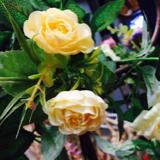
千日红又叫百日红、火球花,千日红适生于疏松肥沃的土壤,喜充足的阳光和炎热干燥的气候。千日红花期很长,可从6月一直开到11月霜降前,因为千日红的花期比较的长,所以很受欢迎!本文主要介绍千日红养殖方法。

千日红的养殖方法
1、土壤管理
百日红性强健,易于栽培,对土壤要求不严,但栽种于深厚肥沃的砂质壤土中生长最好。
2、施肥管理
除在定植时用腐熟鸡粪作为基肥外,生长旺盛阶段还应每隔半个月追施1次富含磷、钾、的稀薄液体肥料。
3、浇水管理
千日红喜微潮、偏干的土壤环境,较耐旱。因此当小苗重新长出新叶后,要适当控制浇水;当植株花芽分化后适当增加浇水量,以利花朵正常生长。
4、光照管理
千日红喜阳光充足的环境,栽培过程中,应保证植株每天不少于4个小时的直射阳光。栽培地点不可过于隐蔽,否则植株生长缓慢、花色暗淡。
5、修剪管理
当苗高15cm时摘心1次,以促发分枝。以后,可根据生长情况决定是否进行第2次摘心。整形修剪时应注意对植株找圆整形,以使千日红有较高的观赏价值。当植株成型后,对枝条摘心可有效地控制花期。
6、花期管理
花朵开放后,保持盆土微潮状态即可,注意不要往花朵上喷水,要停止追施肥料,保持正常光照即可。花后应及时修剪,以便重新抽枝开花。
7、病害防治
千日红苗期易发生立枯病。防治方法,可于播种前5-6天,用1500倍液的立枯宁处理苗床;亦可用1000倍液的立枯宁对病株灌根。

千日红的养殖方法
1、土壤管理
百日红性强健,易于栽培,对土壤要求不严,但栽种于深厚肥沃的砂质壤土中生长最好。
2、施肥管理
除在定植时用腐熟鸡粪作为基肥外,生长旺盛阶段还应每隔半个月追施1次富含磷、钾、的稀薄液体肥料。
3、浇水管理
千日红喜微潮、偏干的土壤环境,较耐旱。因此当小苗重新长出新叶后,要适当控制浇水;当植株花芽分化后适当增加浇水量,以利花朵正常生长。
4、光照管理
千日红喜阳光充足的环境,栽培过程中,应保证植株每天不少于4个小时的直射阳光。栽培地点不可过于隐蔽,否则植株生长缓慢、花色暗淡。
5、修剪管理
当苗高15cm时摘心1次,以促发分枝。以后,可根据生长情况决定是否进行第2次摘心。整形修剪时应注意对植株找圆整形,以使千日红有较高的观赏价值。当植株成型后,对枝条摘心可有效地控制花期。
6、花期管理
花朵开放后,保持盆土微潮状态即可,注意不要往花朵上喷水,要停止追施肥料,保持正常光照即可。花后应及时修剪,以便重新抽枝开花。
7、病害防治
千日红苗期易发生立枯病。防治方法,可于播种前5-6天,用1500倍液的立枯宁处理苗床;亦可用1000倍液的立枯宁对病株灌根。
0
0
文章
Colour_
2017年07月04日

天竺葵适宜在春季或秋季扦插,一般土温保持在11~12℃,10~14天即可生根。新老枝条都能插活,但以强剪之后新萌发的嫩枝为最好。可结合秋季换盆,将剪下的枝条剪成长10~15厘米的插条,待切口干燥后插入素沙土中,插后浇1次透水,以后找水保持湿润,1个月左右可生根发芽。冬季或早春剔下过密的枝条,扦插也很容易成苗。播种时应用单瓣的天竺葵种子,播种繁殖有可能选出优良类型。
天竺葵喜凉爽、怕湿热,室温在10~15℃的向阳房间最适合。天竺葵因生长快、开花多,需要每年换盆。早春正值开花季节,6月开花后,又处于不适它生长的湿热季节,以8月下旬至9月上旬换盆为宜。换盆前要进行修剪,将过密枝、纤细枝、病虫枝及徒长枝,一并从基部剪去,留分布均匀的主枝3~5个,然后再将主枝及侧枝再短截,每个侧枝仅留3个侧芽,使整个植株枝条分布均匀、紧凑,株形丰满矮壮。用腐熟饼肥、骨粉等作基肥,栽后2天才能浇水。
天竺葵根系多肉质,性喜干燥而忌水湿。夏季气温高在35℃以上时,天竺葵呈半休眠状态,要严格控制浇水,以盆土不过干即可,同时以早晚浇水为宜,中午土温较高时切不可浇水,防止引起根须腐烂。
10月初天气转凉时,晚上把盆花搬进房内。当室外白天气温降低到5时,固定在室内有阳光处养护,浇水要见土面发白再浇,浇水后松土。天竺葵喜干,盆土不可积水久湿。每周转盆1次,使叶面均匀着光,以保持棵形匀称美观。天竺葵叶面生有绒毛,易着尘土污染,可在晴天时,搬出室外用温水冲洗干净,不要经常向叶面洒水,以免污垢影响观赏。
天竺葵喜凉爽、怕湿热,室温在10~15℃的向阳房间最适合。天竺葵因生长快、开花多,需要每年换盆。早春正值开花季节,6月开花后,又处于不适它生长的湿热季节,以8月下旬至9月上旬换盆为宜。换盆前要进行修剪,将过密枝、纤细枝、病虫枝及徒长枝,一并从基部剪去,留分布均匀的主枝3~5个,然后再将主枝及侧枝再短截,每个侧枝仅留3个侧芽,使整个植株枝条分布均匀、紧凑,株形丰满矮壮。用腐熟饼肥、骨粉等作基肥,栽后2天才能浇水。
天竺葵根系多肉质,性喜干燥而忌水湿。夏季气温高在35℃以上时,天竺葵呈半休眠状态,要严格控制浇水,以盆土不过干即可,同时以早晚浇水为宜,中午土温较高时切不可浇水,防止引起根须腐烂。
10月初天气转凉时,晚上把盆花搬进房内。当室外白天气温降低到5时,固定在室内有阳光处养护,浇水要见土面发白再浇,浇水后松土。天竺葵喜干,盆土不可积水久湿。每周转盆1次,使叶面均匀着光,以保持棵形匀称美观。天竺葵叶面生有绒毛,易着尘土污染,可在晴天时,搬出室外用温水冲洗干净,不要经常向叶面洒水,以免污垢影响观赏。
0
0
文章
小九
2017年07月04日

花名:#彩叶草
别名:五彩苏、老来少、五色草、锦紫苏
花期:11~12月
送花对象:不宜送人
花语:绝望的恋情

彩叶草是多年生草本植物,由于其叶色丰富,是优良的观彩叶类花卉植物。叶子的彩色都各不相同,黑暗中会发出七色的光茫,犹如多彩的夜明珠。常用于花坛、会场、剧院布置图案,也可作为花篮、花束的配叶。据说彩叶草是有灵性的,心灵纯洁的人拥有它,它会发出光亮并带给你幸福;反之,它就会日渐枯萎光彩不再。
别名:五彩苏、老来少、五色草、锦紫苏
花期:11~12月
送花对象:不宜送人
花语:绝望的恋情

彩叶草是多年生草本植物,由于其叶色丰富,是优良的观彩叶类花卉植物。叶子的彩色都各不相同,黑暗中会发出七色的光茫,犹如多彩的夜明珠。常用于花坛、会场、剧院布置图案,也可作为花篮、花束的配叶。据说彩叶草是有灵性的,心灵纯洁的人拥有它,它会发出光亮并带给你幸福;反之,它就会日渐枯萎光彩不再。
0
0
文章
秋田
2017年06月19日


#悬崖菊 的盆景制作
在制作悬崖菊盆景的时候,首先要选择合适的花材,一般是选择的单瓣品种的菊花,要求分枝多,并且枝条柔软,开花密集。
在11月份的时候,要选取合适的脚芽,将其栽进口径大约在50cm的花盆里面,放进室内,保持充足的光照。并且需要保持土壤的湿润。
在菊花生长的时候,要注意,不要摘心,并且要加强水肥的管理,任其生长。等到第二年的三月份的时候,可以移出室外,并且脱盆,最好是栽植在露地上,这样,它的长势会比较好。盆栽的话,最好是栽植在口径45cm的花盆里面。
菊花栽植之后,可以用竹竿做一个架子,注意做成基部高,顶部低,基部宽顶部窄的样子。架子要长度在2米左右,宽度在半米左右。
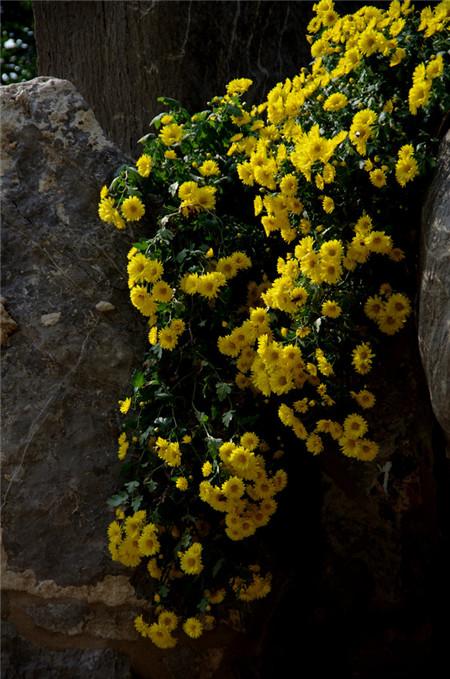
将菊花的枝条从20cm处打弯,用棕丝绑在竹竿上,每生长约10cm就要绑一次,这样,菊花的枝条就会沿着竹竿的横向来平面延伸了。
当菊花的侧枝长出来之后,选择其中生长比较健壮的两个侧枝,和主枝一样进行绑扎,但是不要摘心。其他的枝条可以进行摘心,保留适当的叶子。等到侧枝上长出来新的侧枝的时候,也要进行摘心,这样就可以促使其多分枝。
在到9月份之前,要一直进行摘心,直到9月份定型,
此后要注意加强水肥管理,在花蕾形成之后,要停止施肥,并将支架拆除,这样植株就可以自然的下垂了。静待赏花即可。
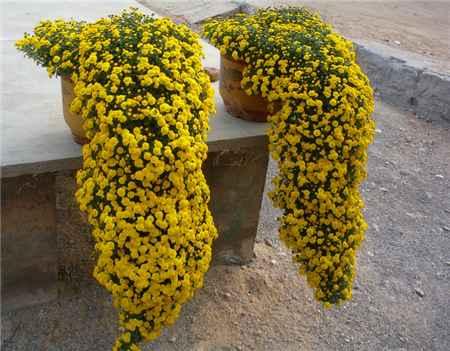
0
0







